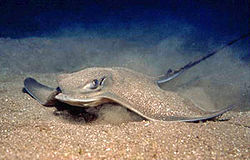| Eagle ray Temporal range: Late Cretaceous to Recent [1] | |
|---|---|
 | |
| Bull ray (Aetomylaeus bovinus) | |
| Scientific classification | |
| Kingdom: | Animalia |
| Phylum: | Chordata |
| Class: | Chondrichthyes |
| Subclass: | Elasmobranchii |
| Division: | Batomorphi |
| Order: | Myliobatiformes |
| Family: | Myliobatidae Bonaparte, 1838 |
| Genera | |
The eagle rays are a group of cartilaginous fishes in the family Myliobatidae, consisting mostly of large species living in the open ocean rather than on the sea bottom.
Contents
Eagle rays feed on mollusks and crustaceans, crushing their shells with their flattened teeth. They are excellent swimmers and are able to breach the water up to several meters above the surface. Compared with other rays, they have long tails, and well-defined, rhomboidal bodies. They are ovoviviparous, giving birth to up to six young at a time. They range from 0.48 to 5.1 m (1.6 to 16.7 ft) in length and 7 m (23 ft) in wingspan. [1]

